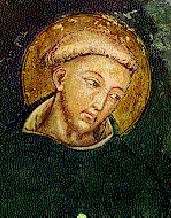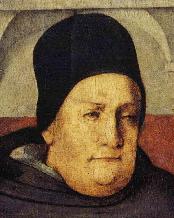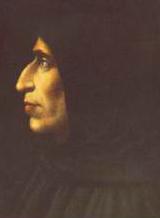Who were the
Cathars or Albigensians?
-
As Europe finally
shook off the economic hardship of the Dark Ages (500 - 1100 AD) and began
to step out into a much larger, and very fascinating world, Europeans began
to break out of the mental and spiritual straitjacket that had held their
minds for centuries. Many Europeans became fascinated not just with
the wealth of the Muslim East--but also the way Muslims thought, especially
about spiritual matters.
-
By the late 1100s
Crusaders had brought back from the East a strange brand of Muslim mysticism
called by its Greek name,
Catharism (the "Pure People").
Europeans were sick of the power games and the moral corruption infecting
the traditional church. Large numbers of people in Italy, southern
Germany and southern France hungered for a lifestyle that would bring them
back into a sense of a closer relationship with God. Thus Cathar
mysticism--along with its very strict moral code--began to spread quickly
and extensively in Europe.
-
The Catholic church
grew very alarmed at this heresy--for it was stirring an enthusiasm among
the people that the church couldn't match. The church thus decided
to strike back and in 1184 the Roman Pope called for a crusade against
the Cathars (they were known as "Albigensians" in Southern France).
"Crusaders" were turned loose on the Cathars: they were authorized
by the Church to kill the Cathars and were awarded whatever lands they
were able to take from their helpless victims.
-
The Crusade proved
to be so devastating among the Albigensians in Southern France that it
completely destroyed a beautiful Southern French cultural "awakening" and
left the land and people devastated for centuries to come.
Why were Peter
Waldo and the Waldensians persecuted by the church?
-
At about the same
time, in around 1175, a devout Frenchman named Peter Waldo began
to call Christians to the task of teaching and spreading the gospel.
The heart of their teaching was scripture--rather than the traditional
teachings of the Catholic church. Very soon Waldo and the "Waldensians"
were having a strong appeal among a European people hungry for spiritual
teaching.
-
The church reacted
to Waldensianism the same way that it did to Catharism. Thus in 1184
Waldensianism was condemned by the Church right along with Catharism, despite
the fact that Waldo's teachings were very traditional in their Christian
theology.
-
The Church did
not want to be challenged in its authority by "upstarts" from outside the
hierarchy of professional priests--no matter how truly Christian the teachings
of these upstarts might be. Thus Waldo and the Waldensians were chased
out of Germany, France, and most of Italy. But Waldensianism survived
in the mountainous hideaways in the Swiss and Italian Alps--where over
300 years later it was eventually incorporated into the Protestant movement
that began to sweep Europe in the 1500s.

How
did St. Francis avoid the same fate?
-
It was not much
later that an Italian named Giovanni Bernardone, nicknamed "Francis"
because he loved to travel so much with his merchant father to France,
started a spiritual movement of his own, "rebuilding" the Church as a voice
of God instructed him to do. He and his followers, called "Franciscans,"
gave up all their personal wealth to serve the poor, the sick and
the unschooled people in the name of Jesus Christ.
-
He too came close
to being condemned by the Roman Church. But he had strong supporters
in Rome. In 1215, by finally and reluctantly agreeing to bring his
movement under Church discipline (although he feared that by doing so his
movement would end up being drawn back into the politics of the wealthy
and powerful Church) Francis avoided being declared a "heretic."
-
Indeed so popular
was Francis and his work that the Church had to recognize him soon
after his death as a true "saint." His movement, the Franciscans,
continued their work of teaching and charity long after him. In fact
the Franciscan Order is still in existence today.
What was Christian
"mysticism"?
-
The monasteries
had long been places of refuge (even since the last days of the Roman Empire)
where common people could remove themselves from a corrupt and cruel world
in order to devote themselves to worshiping and serving God. These centers
of learning and faith had kept the small light of Western culture alive
during the long run of the "Dark Ages" from the late 400s to the mid 1000s
AD.
-
Now that the West
was coming out from under the long period of invasion from Germans, Arabs,
Vikings, Hungarians, Bulgars, etc., and now that wealth and power were
returning to the West, the European Church found itself in a struggle with
European princes and kings to grab as much of this new wealth and power
as possible.
-
Many of the Europeans
were discontent, even disgusted, with this new focus on the offerings of
material culture. Certainly Waldo and Francis were part of this spirit.
-
The monasteries,
as places of retreat from the world, began to attract such people in large
numbers. Many of the monks (men) and nuns (women) in these monasteries
not only devoted themselves to a life of prayer but also to the writing
of hymns and the painting of religious art, focused on the bliss of life
in relationship with God and the heavenly saints. A rich culture
of a Christian "inner spirit" began to grow up in some of the monasteries
in competition with the new secular culture of wealth and power of the
larger Church. Christians who took up this life of the inner spirit
were eventually called "mystics."
-
The Church tolerated,
even encouraged, Christian mysticism--as long as it stayed roughly within
the bounds of traditional Church teachings and as long as it continued
to discipline itself under Roman or Catholic authority.
What was Christian
scholasticism?
-
The Church felt
that it had to bring under its own religious discipline the waking mind
of the West. In the 1100s and 1200s, new schools were being built
in connection with the cathedrals of the many newly wealthy European bishops.
These schools began to offer instruction to talented young minds who were
willing to offer their intellectual service to the bishops.
-
Scholars and "doctors"
of the church were attracted to these schools to offer this instruction
in an ever-widening field of study that included not only theology but
also astronomy, medicine, mathematics and physics. So broad was the
scope of instruction and learning that these schools were eventually called
"universities."
-
 In
the early 1200s a Spanish monk of the Augustinian Order, Dominic
de Guzman, proposed to the Pope the creation of a new teaching order, the
Order of Preaching Brothers (later simply called the "Dominicans").
When the Dominicans proved their zeal in hunting down heretic Cathars and
Waldensians, the Popes extended to them ever greater authority to "teach"
the European hearts. Not only did the Dominicans open schools around
Europe, they became leading scholars in the new universities. (They
also later became the directors of the Inquisition, whose job was to hunt
down and eradicate "heretics" within the Christian world.) In
the early 1200s a Spanish monk of the Augustinian Order, Dominic
de Guzman, proposed to the Pope the creation of a new teaching order, the
Order of Preaching Brothers (later simply called the "Dominicans").
When the Dominicans proved their zeal in hunting down heretic Cathars and
Waldensians, the Popes extended to them ever greater authority to "teach"
the European hearts. Not only did the Dominicans open schools around
Europe, they became leading scholars in the new universities. (They
also later became the directors of the Inquisition, whose job was to hunt
down and eradicate "heretics" within the Christian world.) -
 By
the late 1200s the University of Paris was attracting key scholars to its
work--the most famous of whom was the Dominican scholar
Thomas Aquinas. By
the late 1200s the University of Paris was attracting key scholars to its
work--the most famous of whom was the Dominican scholar
Thomas Aquinas. -
What Aquinas and
other scholars or "scholastics" were attempting to do was to bring all
learning under a single system of knowledge, one presumably that the Church
could then control. They considered every known fact and debated
and debated where and how such facts could fit into the larger system.
They studied the ancient Greek philosophy of Plato and Aristotle (300 years
before Christ)--but particularly Aristotle because he too had tried to
organize all knowledge under a single system of learning.
-
For about a century
such scholasticism swept the universities of Paris, Oxford, Padua, etc.
as university scholars tried to bring all knowledge, all the "facts" of
the universe under human control (and thus the control of the Church).
-
But by the early
1300s scholasticism was being challenged by independent thinkers such as
the Franciscans, Duns Scotus and
William of Occam.
They showed that "fact" was indeed only how the human mind organized the
details of life--and that fact had no permanent existence but changed from
human observer to human observer, depending on a person's feelings or perspective
on things. They also reminded everyone that our knowledge of the
greatest thing of all, God, came to us not as a fact of the mind but as
the reward of simple faith.
-
This anti-scholasticism
of the Franciscans was to have two effects:
-
1) to get the
European mind (briefly) off the idea of organizing all knowledge as "fact"
and
-
2) to separate
the faith of the heart from the study of the "facts" of the world around
us.
-
This gave Western
science a bit of an opportunity to grow up without having having constantly
to answer to theology--although it would still take some time (a couple
of more centuries) before the Church would let up enough on scientists
to allow them to do their research without the fear of being branded as
"heretics."
Why were John
Wycliff and Jan Huss persecuted?
-
There was always
a very narrow limit, of course, as to how much the Church was willing to
tolerate concerning the criticism by some people of its obvious hunger
for wealth and power.
-
At Oxford university,
John Wycliff by 1370 stirred up controversy in teaching the personal
freedom of the individual believer, who stood in matters of faith
accountable only to God--and to no one else. Wycliff also pointed
out that many of the practices of the church not only had no support from
scripture but indeed went against what scripture clearly taught about the
Christian life. To demonstrate his point he translated the Latin
Bible into English so that the common Englishman could read for himself
what it was that God and Christ had once taught the world.
-
Soon his teachings
not only had stirred up Oxford University but were spreading to the universities
on the continent.
-
The Church was
furious about his challenge to its unquestioned authority--but seemed unable
to do anything about them until after his death in 1384, when he was finally
branded as a heretic and attempts were made to have his English Bibles
destroyed. The Church also made it illegal to translate the Bible
from the Latin into the language of the people, claiming that only the
clergy were sufficiently well trained to be able to interpret "correctly"
what scripture taught (meaning, whatever was convenient for the power and
authority of the Church).
-
 In
the early 1400s, in Bohemia, John or Jan Huss picked up on Wycliff's
teachings and began presenting pretty much the same ideas at the University
of Prague. He too translated the Latin Bible into the language of
his people, Czech--knowing full well of the danger he was running by doing
so. In
the early 1400s, in Bohemia, John or Jan Huss picked up on Wycliff's
teachings and began presenting pretty much the same ideas at the University
of Prague. He too translated the Latin Bible into the language of
his people, Czech--knowing full well of the danger he was running by doing
so. -
This was very
bad timing because the Church was already in a state of major turmoil--the
politics of the time having produced three different people claiming to
be the true Pope. A number of Church councils were called in order
to try to straighten out the miserable mess the Church was in. One
of these Councils, the Council of Constance also decided to call Huss to
present himself in order to explain why he had been disobeying the Church.
-
Although he was
promised that he could come and go at Constance without harm, Huss was
soon arrested after his arrival in 1415 and burned at the stake as a heretic.
Bohemia immediately exploded in anger. The Church tried to put down
the riots with force--and then with a promise of compromise, offering the
people more opportunity to learn the faith on their own.
-
But the Church
soon put their promises aside, using as an excuse the need for total unity
behind the Church in its response to the military threat of the Muslim
Turks on the Eastern borderlands of Christian Europe.

Who
was Savonarola?
-
Italy in the 1400s
was becoming very, very wealthy. Trade between Northern Europe and
the Muslim East, which passed through Italy, had made many Italian individuals
and even cities very wealthy. Venice, Milan, Pisa, Siena, Florence
and Rome had come to take on the wealthy look that had once belonged only
to the cities of Islam. It looked as if a "rebirth" or "Renaissance"
of the wealth and power of ancient Rome had taken place.
-
This look of wealth
had also come to the Church, which had also grown fantastically rich in
land, servants, churches, monasteries and schools. The Church even
owned whole cities in Europe.
-
In Florence, perhaps
the wealthiest of all Italian Renaissance cities, a Dominican monk named
Girolamo Savonarola had during the late 1400s turned the city upside
down with his preaching which denounced the wealth of the Florentine commercial
aristocracy (which included many bishops in the Church) and the poverty
of the common people. As Savonarola's popularity with the common
people grew greater so did the hatred of the rich and powerful of the city.
But when Savonarola proved to be just as forceful in insisting on the cleaning
up of the morals of the common people, he lost their support. He
was finally hanged in 1498.
What was the
mood like in the Church as the 1500s loomed into view?
-
The Church was
under attack for its corruption in wealth and power. But it seemed
unable to do anything to clean up its own act.
-
The Church always
proved to be outraged when any criticism was directed its way. It
insisted that it alone had the right to determine what was right and what
was wrong--since it alone was the the Bride of Christ and the Popes alone
were the vicars (caretakers) of God on earth.
-
Not only was the
Church insensitive to moral questioning, its own behavior at times was
shocking. Some of the popes were cruel, morally sick, and ambitious
for wealth and power without limit. They used the wealth of the church
to play their political games with the newly wealthy and newly rising princes
and kings of Europe--dragging the church into the most sordid experience
of power politics.
-
In short, by the
early 1500s, the Church was ripe for a sweeping movement of reform, from
top to bottom, from coast to coast.
|






 Miles
H. Hodges
Miles
H. Hodges